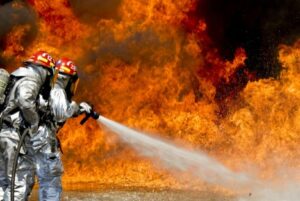
Summer brings more than just long days and warm weather—it brings a unique set of safety concerns for facility managers. As temperatures rise and activity in and around buildings increases, fire risk becomes a real concern. From overheating systems to distracted seasonal staff, the factors that can contribute to fire hazards grow quickly if not kept in check.
Staying compliant with fire safety regulations isn’t just about checking a few boxes. It’s about protecting your people, your property, and your operations. And when the heat is on, so is the pressure to get it right. That’s where proactive maintenance and safety planning can make all the difference.
At RKB Facility Solutions, we work with clients nationwide to stay ahead of seasonal fire hazards and remain compliant year-round. Below are five essential areas to focus on this summer to avoid costly incidents and ensure peace of mind.
1. Run a Full Summer Fire Safety Inspection
Start with a thorough walk-through of your facility. This isn’t just a routine—it’s your first and most critical line of defense.
Inspections should go beyond visual checks. They should include functional testing, reviewing placement and access to safety equipment, and making sure nothing has been blocked or neglected. Seasonal heat can place stress on your building systems, so it’s important to ensure that everything is in working order now—before a fire emergency exposes any gaps.
Key tips:
- Check that fire extinguishers are properly charged, visible, and recently serviced
- Test alarms and smoke detectors for functionality
- Ensure emergency lighting and exit signage is illuminated and visible
- Inspect sprinkler systems for corrosion, blockages, or damage
- Clear access to electrical panels and remove any surrounding obstructions
2. Get Your Fire Compliance Documentation in Order
Paperwork may not be glamorous, but when it comes to fire safety, it can be the difference between a smooth inspection and major fines—or worse, liability in an emergency.
Every facility should maintain up-to-date records that clearly demonstrate ongoing compliance. That includes records of inspections, training sessions, emergency plans, and maintenance. Inconsistent or missing documentation can raise red flags with inspectors and leave your facility vulnerable.
Key tips:
- Store recent inspection certifications in an easily accessible format
- Post updated evacuation plans in visible, public areas
- Keep a log of fire drills and training events
- Maintain records for sprinkler and alarm servicing
- Review your insurance documentation to ensure it reflects current fire protection systems
3. Watch Out for Summer-Specific Fire Hazards
Hot weather brings its own fire risks that don’t exist during other seasons. Equipment often runs harder and longer, staff may get complacent with safety practices, and people may be using unfamiliar areas of the building more frequently.
Being aware of these seasonal hazards allows you to create safeguards before something goes wrong.
Key tips:
- Monitor HVAC systems that may be overheating due to heavy use
- Keep mechanical rooms clear and ensure vents are unobstructed
- Designate and monitor outdoor smoking areas—don’t place them near dry mulch or trash
- Limit the use of extension cords and ensure they meet commercial safety standards
- Remind staff to unplug unused appliances in kitchens and break rooms
4. Maintain Outdoor Areas for Fire Prevention
When we think about fire hazards, we often focus on the interior. But summer heat and dry weather can turn your facility’s exterior into a tinderbox—especially if landscaping isn’t well-maintained.
Even something as simple as a cigarette butt in dry mulch can quickly lead to a much larger issue. Properly managing your grounds reduces the risk of ignition and helps maintain access for emergency responders.
Key tips:
- Trim dry brush and remove dead landscaping debris
- Make sure fire lanes and access roads are always unobstructed
- Clear leaves and debris from gutters and rooftops
- Keep dumpsters and outdoor storage bins at a safe distance from the building
5. Make Sure Everyone Knows What to Do
Your systems and protocols only work if your people know how to use them. Fire safety training should be part of your regular schedule—not a one-time event. That’s especially true during the summer when facilities often rely on seasonal employees or rotating shifts.
When everyone knows how to respond, emergencies are less likely to escalate. Clear signage, consistent drills, and easy-to-understand materials go a long way toward building a safety-minded culture.
Key tips:
- Train staff to identify and report fire hazards early
- Review evacuation routes during team meetings or safety huddles
- Ensure everyone knows how to use extinguishers appropriately
- Remind teams what steps to take immediately when alarms sound
The High Cost of Overlooking Fire Risks
Ignoring summer fire risks can have serious consequences. Beyond the physical damage, fires can interrupt operations, harm your reputation, and even result in lawsuits or denied insurance claims.
Our team is ready to help you identify vulnerabilities, stay compliant with fire codes, and build a safer environment for everyone who walks through your doors.
Contact RKB Facility Solutions today to schedule a seasonal fire safety assessment or request a custom checklist designed for your specific facility needs.







